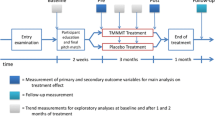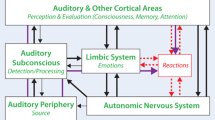Abstract
This paper presents a series of 12 cases of chronic tinnitus patients who participated in 4 weeks of auditory discrimination training either close to or far removed from the tinnitus frequency. The training was based on the assumption that tinnitus is related to a shift of the representation of the tinnitus frequency in auditory cortex outside of the normal tonotopic map and that training close to but not removed from the tinnitus frequency should result in a reduction in the severity of the tinnitus. Tinnitus severity was measured 4 times per day during the entire treatment and other tinnitus-related variables were assessed 1 week before and 1 month posttreatment. The comparison of the training close to as compared to remote from the tinnitus frequency did not yield a statistically significant difference. However, a post hoc analysis revealed that patients who engaged in regular training as compared to those who practiced irregularly were significantly more successful in reducing tinnitus severity independent of the trained frequencies. Treatment success was best predicted by days of training and general activity levels. The data suggest that auditory dicrimintion training shows a dose response effect irrespective of training location and that treatment success is also related to psychological variables. For more substantial changes in multiple variables an extended training period with additional consideration of emotional variables would be necessary. In addition, controls for nonspecific training effects need to be implemented.
Similar content being viewed by others
REFERENCES
Andersson, G., Lyttkens, L., Hirvela, C., Furmark, T., Tillfors, M., & Fredrikson, M. (2000). Regional cerebral blood flow during tinnitus: A PET case study with lidocaine and auditory stimulation. Acta Oto-Laryngologica, 120, 967-972.
Derogatis, L. R. (1977). The SCL-90-R: Administration, scoring and procedures manual I. Baltimore: Clinical Psychometric Research.
Fordyce, W. E. (1988). Pain and suffering. A reappraisal. American Psychologist, 43, 276-283.
Flor, H., Elbert, T., Knecht, S., Wienbruch, C., Pantev, C., Birbaumer, N., et al. (1995). Phantom limb pain as perceptual correlate of cortical reorganization. Nature, 357, 482-484.
Flor, H., Rudy, T. E., Birbaumer, N., Streit, B., & Schugens, M. M. (1990). Zur Anwendbarkeit des West Haven-Yale Multidimensional Pain Inventory im deutschen Sprachraum [Applicability of the West Haven-Yale Multidimensional Pain Inventory in German-speaking Countries]. Der Schmerz, 4, 82-87.
Flor, H., & Schwartz, M. S. (2003). Tinnitus: Nothing is as loud as a sound you are trying not to hear. In M. Schwartz & F. Andrasik (Eds.), Biofeedback: A practitioner's guide (3rd ed., pp. 750-775). New York: Guilford.
Franke, G. (1995). SCL-90-R. Die Symptom-Checkliste von Derogatis-Deutsche Version [The Symptom-Checklist of Derogatis-German Version]. Göttingen, Germany: Belz.
Goebel, G., & Hiller, W. (1998). Tinnitus-Fragebogen (TF). Ein Instrument zur Erfassung von Belastung und Schweregrad bei Tinnitus [Tinnitus Questionnaire (TQ). An Instrument for The Assessment of Annoyance and Severity of Tinnitus]. Göttingen, Germany: Hogrefe.
Hautzinger, M., & Bailer,M. (1994). Allgemeine Depressions Skala (ADS) [General Depression Scale].Weinheim: Beltz-Test.
Jastreboff, P. J., & Jastreboff, M. M. (2000). Tinnitus Retraining Therapy (TRT) as a method for treatment of tinnitus and hyperacusis patients. Journal of the American Academy of Audiology, 11, 162-177.
Kerns, R. D., Turk, D. C., & Rudy, T. E. (1985). The West Haven-Yale Multidimensional Pain Inventory (WHYMPI). Pain, 23, 345-356.
Lockwood, A. H., Salvi, R. J., Burkard, R. F., Galantowicz, P. J., Coad, M. L., & Wack, D.S. (1999). Neuroanatomy of tinnitus. Scandinavian Audiology, 51 (Suppl.), 47-52.
Lockwood, A. H., Salvi, R. J., Coad, M. L., Towsley, M. L., Wack, D. S., & Murphy, B. W. (1998). The functional neuroanatomy of tinnitus: Evidence for limbic system links and neural plasticity. Neurology, 50, 114-120.
Mirz, F., Gjedde, A., Sodkilde-Jorgensen, H., & Pedersen, C. B. (2000). Functional brain imaging of tinnitus-like perception induced by aversive auditory stimuli. Neuroreport, 11, 633-637.
Muehlnickel, W., Elbert, T., Taub, E., & Flor, H. (1998). Reorganization of auditory cortex in tinnitus. Proceedings of the National Academy of Sciences of the United States of America, 95, 10340-10343.
Radloff, L. S. (1977). The CES-D Scale: A self-report depression scale for research in the general population. Applied Psychological Measurement, 1, 385-392.
Recanzone, G. H., Schreiner, C. E., & Merzenich, M. M. (1993). Plasticity in the frequency representation of primary auditory cortex following discrimination training in adult owl monkeys. Journal of Neuroscience, 13, 87-103.
Author information
Authors and Affiliations
Corresponding author
Rights and permissions
About this article
Cite this article
Flor, H., Hoffmann, D., Struve, M. et al. Auditory Discrimination Training for the Treatment of Tinnitus. Appl Psychophysiol Biofeedback 29, 113–120 (2004). https://doi.org/10.1023/B:APBI.0000026637.77671.f4
Issue Date:
DOI: https://doi.org/10.1023/B:APBI.0000026637.77671.f4




